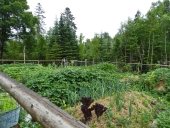





















 So yeah...the trees and vines and whatever stuff that covers the ground is SO THICK that you get tangled if you try to go through. I don't want to till, I want to keep whatever system is underground natural so that it will feed whatever system I can create. I love that it's been untouched where we've cut the trees down. The chickens and goats have been scratching and pulling on and around all the stumps and vines while fertilizing the areas. Plus the straw I use for bedding is spread all over as I clean out their areas. So I guess you can say we've been naturally composting since we moved in in March. Good to know that so far, without knowing much, we've been doing ok for our land.
So yeah...the trees and vines and whatever stuff that covers the ground is SO THICK that you get tangled if you try to go through. I don't want to till, I want to keep whatever system is underground natural so that it will feed whatever system I can create. I love that it's been untouched where we've cut the trees down. The chickens and goats have been scratching and pulling on and around all the stumps and vines while fertilizing the areas. Plus the straw I use for bedding is spread all over as I clean out their areas. So I guess you can say we've been naturally composting since we moved in in March. Good to know that so far, without knowing much, we've been doing ok for our land.








JoAnn McCoy wrote:
Now about those trees, if I were to go to our local nursery/tree farm...what should I ask for to know that I'm getting the right thing to start with?








Chris Badgett
Cocreator of Organic Life Guru. Have you seen what's happening over there?




Chris Badgett
Cocreator of Organic Life Guru. Have you seen what's happening over there?

|
There's a way to do it better - find it. -Edison. A better tiny ad:
Learn Permaculture through a little hard work
https://wheaton-labs.com/bootcamp
|





